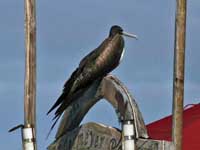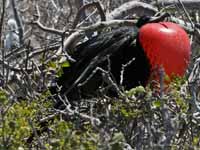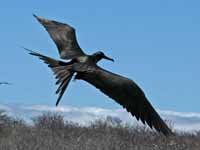THE WORLD BIRDS - An Online Bird Book
SULIFORMES
Frigates
Order Suliformes Family Fregatidae - 1 genus
SULIFORMES
The Suliformes order is made up of 4 families: anhingas (Anhingidae), cormorants (Phalacrocoracidae), bobbies and gannets (Sulidae), and frigatebirds (Fregatidae). These are diving birds, they plunge for prey, often from a considerable height. Because of this, their nostrils are protected from water inhalation. For example, gannets nostrils are located inside their mouth. Suliforme chicks are altricial; they are born naked and helpless. Most of the order have large wingspans. An exception is the flightless cormorant of the Galapagos.
Suliformes all have webbing that connects four toes. Ths is also true for pelicans and tropicbirds. They contrast with ducks ang geese that have just 3 webbed toes. Quite recently, all of the suliformes were considered to belong to the same order as the pelicans: Pelicaniformes. Suliformes share another property with the pelicans, they all have bare gular sacs. Of course, this sac has evolved to the extreme with pelicans which use it for fishing.
Suliformes all have webbing that connects four toes. Ths is also true for pelicans and tropicbirds. They contrast with ducks ang geese that have just 3 webbed toes. Quite recently, all of the suliformes were considered to belong to the same order as the pelicans: Pelicaniformes. Suliformes share another property with the pelicans, they all have bare gular sacs. Of course, this sac has evolved to the extreme with pelicans which use it for fishing.
Frigates
Order Suliformes Family Fregatidae - 1 genus
Frigatebirds are large, with iridescent black feathers (the females have a white underbelly), with long wings and deeply-forked tails. Frigatebirds are found over tropical oceans and ride warm updrafts. Having the largest wingspan to body weight ratio of any bird, they are essentially aerial, able to stay aloft for more than a week, landing only to roost or breed on trees or cliffs. Because of their great flying ability, the legs have evolved to be small. These birds do not swim, cannot walk well, and cannot take off from a flat surface. Fish are caught in the air, or close to the surface via the birds long bill.
Female frigatebirds are slightly larger than males. The males have inflatable red-colored throat pouches which they inflate to attract females during the mating season. Nests are made of sticks and other material. The nest is place in trees if available; cliffs and bushes are also utilized. They are place on the ground as a last resort since the eggs and chicks are vulnerable to predators there. Incubation and feeding of chicks is shared by the parents. The fledged chicks take months before they are able to obtain all the food they need. In the meanwhile, the eat regurgitated food brought by the adults.
The birds were named after the frigate ships of pirates that plunder more helpless vessels. Frigatebirds are famous for harassing other marine species such as boobies and stealing their food. Although this reputation is well deserved, it is not their predominate means of getting food. They skim close to the surface and catch flying fish or fish very close to the surface.
Genus Fregata
Frigatebird, Ascension Island Fregata aquila
Description: The male Ascension Island frigatebird has black plumage and red gular (throat) sac. The female has black plumage and a blue eye-ring. A juvenile has awhite head plus brown and white breast; white belly. The Ascension Island frigatebird is 90 to 95 cm long.
Range: It breeds on Ascension Island and the adjacent Boatswain Bird Island which are tropical Atlantic Ocean islands about half way between South America and Africa, but its range off Africa is not well known because of similarity to magnificent frigatebird.
Habitat: Pelagic except when breeding.
Diet: Fish, especially flying fish. Also baby turtles
Conservation status: It is listed as Vulnerable because of its small breeding range and population. Feral cats decimated to colony on Ascension Island in 1815. They are being reintroduced that and also breed on Boatswain Bird Island, but cats could be introduced again.
Image by: 1, 2, 3, 4, 5) Drew AveryRange: It breeds on Ascension Island and the adjacent Boatswain Bird Island which are tropical Atlantic Ocean islands about half way between South America and Africa, but its range off Africa is not well known because of similarity to magnificent frigatebird.
Habitat: Pelagic except when breeding.
Diet: Fish, especially flying fish. Also baby turtles
Conservation status: It is listed as Vulnerable because of its small breeding range and population. Feral cats decimated to colony on Ascension Island in 1815. They are being reintroduced that and also breed on Boatswain Bird Island, but cats could be introduced again.
1) Chick 2) Juvenile 3) Female 4, 5) Male
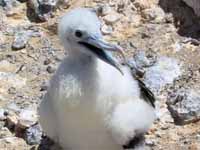
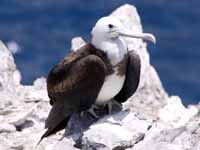
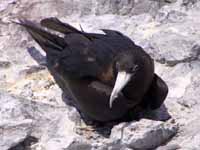
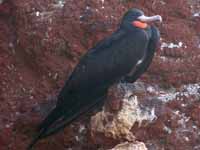

Frigatebird, Christmas Island Fregata andrewsi Found: Christmas Island of the Indian Ocean Vagrant: Australasia
Description: The male Christmas Island frigatebird is all black except for a white belly patch and a red gular sac. The female has a white breast and upper-belly. The male Christmas Island frigatebird is 90 to 100 cm long.
Range: Christmas Island for breed, but can travel 1000s of km from there.
Habitat: Nests in tall trees.
Diet: Flying fish, squid.
Conservation status: It is listed as Critically Endangered because its population is small and breeds only on a small island.
Image by: 1) Shah Jahan - Jakarta, Indonesia 2) Martha_de_Jong-Lantink 3) Shah_Jahan 4) Francesco_VeronesiRange: Christmas Island for breed, but can travel 1000s of km from there.
Habitat: Nests in tall trees.
Diet: Flying fish, squid.
Conservation status: It is listed as Critically Endangered because its population is small and breeds only on a small island.
1) Juvenile 2, 3) Female 4) Male
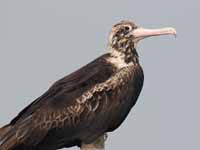
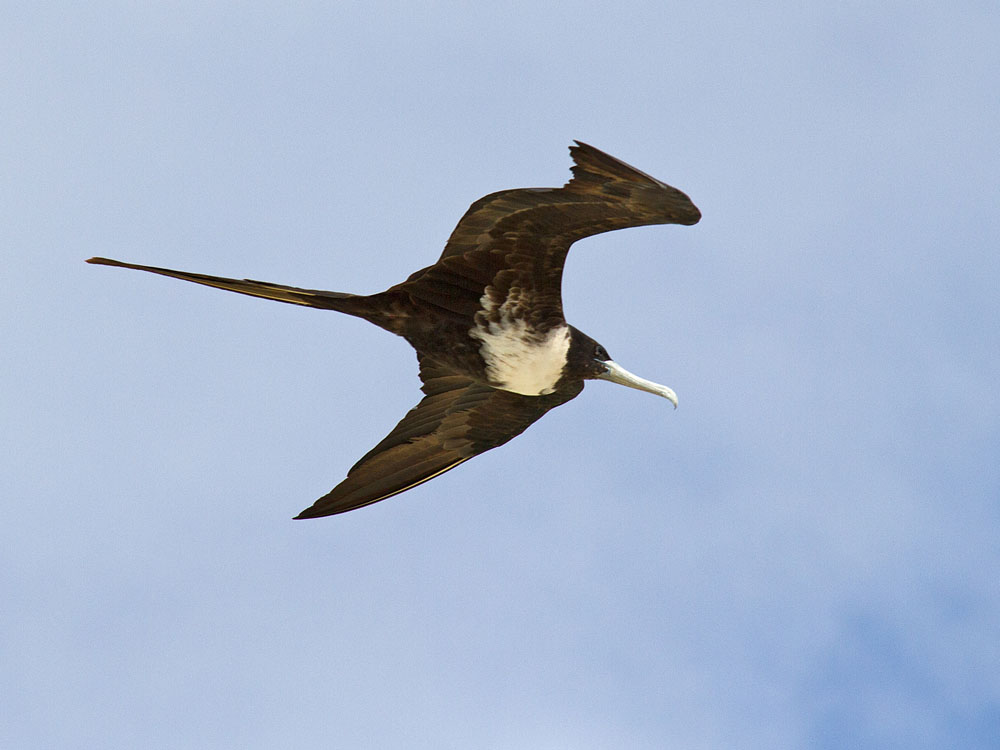

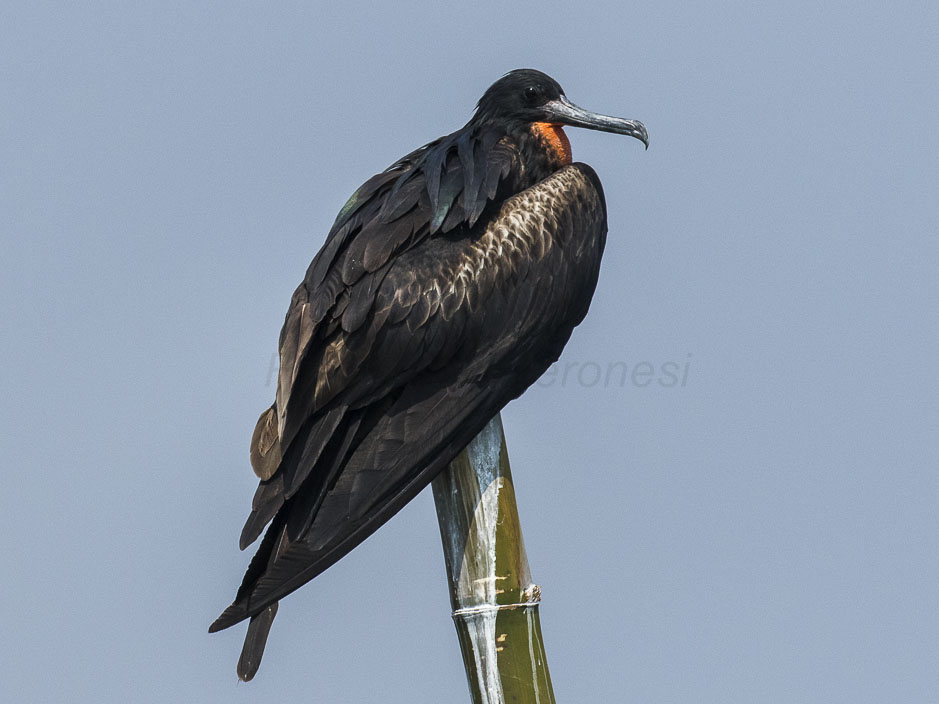
Frigatebird, Great Fregata minor
Description: The male great frigatebird has black plumage with green sheen; red gular (throat) sac. The under-wings have some pale areas, Female has black plumage including head; white breast with grey bib; red eye-ring. The great frigatebird is 85 to 105 cm long. The wingspan is 205 to 230 cm and they weigh up to 1600 grams.
Range: South America, Africa, Asia, Australia, Hawaii, and other Pacific Islands; usually within 25 degrees of the equator.
Habitat: Breeds on remote islands; pelagic over large distances.
Diet: Fish caught near the surface or in the air.
Conservation status: Least Concern.
Image by: 1, 4) Dick - Kauai, Hawaii 2, 5) Len Blumin - Galapagos 3) Dick Daniels - Michaelmas Cay, Great Barrier Reef 6) patrickkavanagh Range: South America, Africa, Asia, Australia, Hawaii, and other Pacific Islands; usually within 25 degrees of the equator.
Habitat: Breeds on remote islands; pelagic over large distances.
Diet: Fish caught near the surface or in the air.
Conservation status: Least Concern.
1) Juvenile 2) Pair 3, 4) Female 5, 6) Male

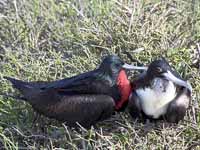
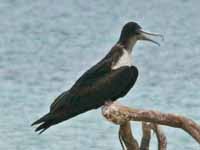
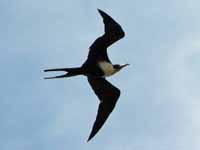
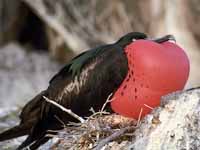
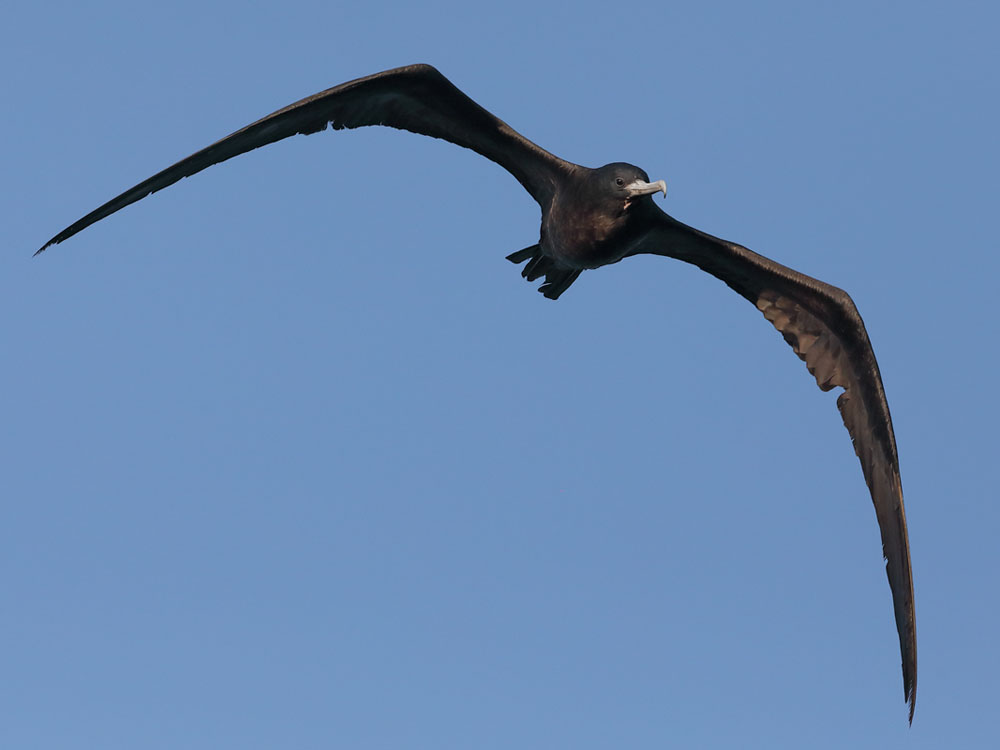
Frigatebird, Lesser Fregata ariel
Description: The male lesser frigatebird has mostly black plumage with a small white patch on the flanks that extends towards the under-wing. A breeding male has large red throat sack. The female has black upperparts, head, neck, and belly. She has a white breast, pink bill, and red eye-ring. A juvenile has black upperparts, and belly. It has a white head, neck, and breast. The jesser frigatebird is 65 to 80 cm long, wingspan 155 to 195 cm. The similar great frigatebird. Great Frigatebird is the largest frigatebird; while the lesser frigatebird is the smallest.
Range: South America, Asia, Africa, Australasia, tropical islands including Christmas Island.<.>
Habitat: Breed on small islands. Afterwards they disperse for thousands of km.
Diet: Mainly fish that are found near the surface. From 25 degrees north to 5 degrees south.
Conservation status: Least Concern.
Image by: 1, 3) Andi Li 2) Aviceda - Western Australia 4) Ariefrahman - North SulawesiRange: South America, Asia, Africa, Australasia, tropical islands including Christmas Island.<.>
Habitat: Breed on small islands. Afterwards they disperse for thousands of km.
Diet: Mainly fish that are found near the surface. From 25 degrees north to 5 degrees south.
Conservation status: Least Concern.
1) Juvenile 2) Juvenile male 3) Female 4) Male
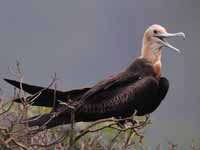
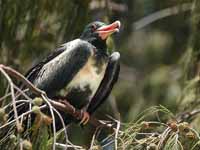
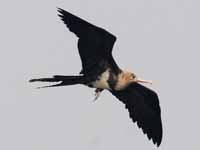
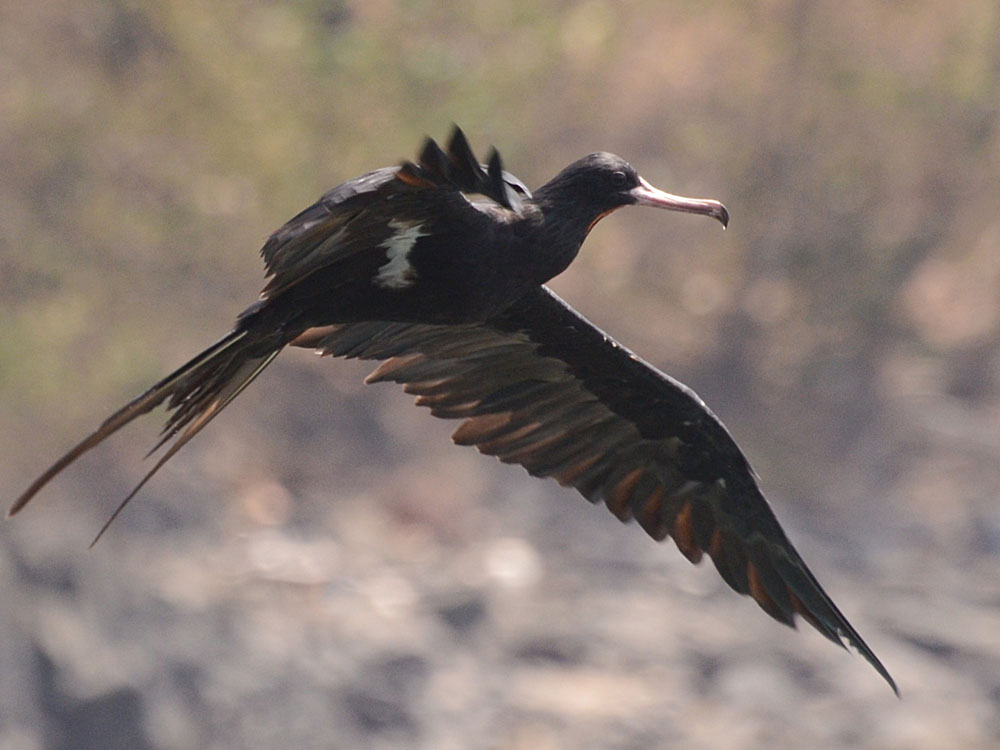
Frigatebird, Magnificent Fregata magnificens
Description: The male magnificent frigatebird has black plumage with purple sheen and a red gular (throat) sac. The female has black plumage including its head; a white breast; and blue eye-ring. The male magnificent frigatebird 90 to 115 cm long.
The similar male great frigatebird bird has a green iridescence sheen to its black plumage while the male Magnificent Frigatebird has purple iridescence sheen. The female great frigatebird has a red eye-ring compared to the female magnificent's blue eye-ring.
Range: The Americas, the Galapagos Islands.
Habitat: Breeds along coasts as well as islands. Pelagic in Atlantic and Pacific Oceans.
Diet: Mainly fish; also squid, jellyfish.
Conservation status: Least Concern.
Image by: 1) Barloventomagico - Venezuela 2, 3, 4, 5) Dick Daniels - Galapago 6) Dick - Isla La Iguana, Panana Range: The Americas, the Galapagos Islands.
Habitat: Breeds along coasts as well as islands. Pelagic in Atlantic and Pacific Oceans.
Diet: Mainly fish; also squid, jellyfish.
Conservation status: Least Concern.
1) Juvenile 2, 3) Female 4 - 6) Male


